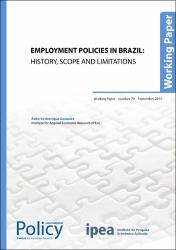Please use this identifier to cite or link to this item:
https://repositorio.ipea.gov.br/handle/11058/15279Full metadata record
| DC Field | Value | Language |
|---|---|---|
| dc.contributor.author | Gonzalez, Roberto Henrique | |
| dc.date.accessioned | 2024-10-03T23:53:46Z | - |
| dc.date.available | 2024-10-03T23:53:46Z | - |
| dc.date.issued | 2010 | |
| dc.identifier.uri | https://repositorio.ipea.gov.br/handle/11058/15279 | - |
| dc.description.abstract | The objective of this paper is to present the main characteristics of the public employment system in Brazil, focusing on its history, scope and current coverage. It seeks to contribute to the debate on social and employment policies, especially as regards creating job opportunities that help people escape from poverty. A conceptual caveat: throughout the paper, the expression “employment policies” is used in a narrow sense to encompass policies “whose specific objectives promote direct and explicit actions within the labour market” (Barbosa and Moretto, 1998: 20). The paper therefore omits other policies that act on macroeconomic factors, labour relations, access to social security and healthcare. While these greatly influence the level and quality of employment in the economy, their actions are beyond the scope of the paper. On the other hand, regulation of certain aspects of working conditions and wages has been regarded as falling within the scope of “employment policy” whenever the goal of such regulation was to affect labour market outcomes directly. This includes setting a minimum wage, for example, but it excludes workplace health and safety standards. The term “public employment system” is reserved for the set of employment policies that are seen as acting together to ensure individuals’ entry or reintegration into the labour market. The paper is divided into three parts. The first outlines the history of employment-related government policies, from the compensation scheme for newly terminated employees and supplemental pay to the design of what it known as the employment system. The second section maps out the scope of existing employment policies and points to the limitations of the public employment system as currently understood by the Brazilian government; it also presents selected indicators concerning the public system’s coverage relative to the Brazilian labour market. The final section highlights a number of issues faced by the public employment system today as regards its ability to reintegrate workers into the labour market. (...) | en |
| dc.language.iso | en | |
| dc.title | Employment Policies in Brazil: History, Scope and Limitations | en |
| dc.type | Working Paper | |
| dc.rights.holder | International Policy Centre for Inclusive Growth | |
| dc.rights.holder | United Nations Development Programme | |
| dc.location.country | Brasil | |
| dc.description.physical | 28 p. : il. | |
| dc.rights.type | Licença total exclusiva | |
| dc.rights.license | O texto e dados desta publicação podem ser reproduzidos desde que as fontes sejam citadas. Reproduções com fins comerciais são proibidas. | |
| dc.subject.keyword | Employment Policies | |
| dc.subject.keyword | Brazil | |
| dc.subject.keyword | History | |
| dc.subject.keyword | Scope | |
| dc.subject.keyword | Limitations | |
| ipea.access.type | Acesso Aberto | |
| ipea.researchfields | N/A | |
| ipea.classification | Emprego. Trabalho | |
| ipea.classification | Direito. Legislação | |
| ipea.classification | Administração Pública. Governo. Estado | |
| ipea.classification | Desenvolvimento Social | |
| Appears in Collections: | Publicações do IPC-IG | |
Files in This Item:
| File | Description | Size | Format | |
|---|---|---|---|---|
| en_IPCWorkingPaper70.pdf | 290.23 kB | Adobe PDF |  View/Open |
Items in DSpace are protected by copyright, with all rights reserved, unless otherwise indicated.

